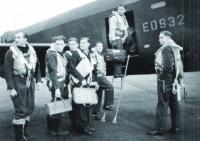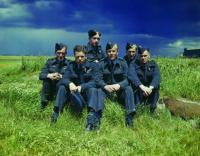
Wing Commander Guy Gibson(top of ladder) and crew.

Big Joe McCarthy

Big Joe McCarthy (third from right) with crew at Scrampton airfield, July 1943.
This week, 70 years ago, the RAFÙs 617 Squadron, led by 24-year-old Wing Commander Guy Penrose Gibson, took off from Scrampton, an airfield in England, to attack dams in the Ruhr Valley of Germany. The Ruhr Valley, formed by the Ruhr River, contained much of GermanyÙs heavy industry. It was thought that if the dams could be breached and the area flooded, German industry would be significantly impaired.
But first, a technique, or bomb, or both, would have to be developed to overcome a number of problems. Among others was the fact that the Germans realized the importance and vulnerability of the dams and had, accordingly, taken steps to protect them. Numerous anti-aircraft batteries, searchlights and torpedo nets were installed on, and around, the dams.
Enter inventor Barnes Neville Wallis. Initially, he proposed to drop a ten-ton bomb from 40,000 feet. The only problem was that there were no bombers capable of flying that high and none capable of carrying a bomb that heavy. Because of the torpedo nets, torpedoes were out. Inspired by skipping stones over the water, he designed a bomb that, if dropped correctly, would skip over the water, and the protective torpedo nets, and come to rest at the dam, and sink to its underwater base. In order to accomplish the objective, and not destroy the plane, Wallis designed the bomb to spin backwards at more than 500 rpms, and installed a detonator activated by water pressure at a depth of 60 feet. Even with the modifications, the bomb, at 10,000 pounds was immense, requiring modifications to the Avro Lancasters tasked with delivering the bomb to the Fatherland. It was determined that the most favorable combination of speed and altitude was 240 mph and 58 feet above the surface.
Finally, all was ready, and over the opposition of RAF Bomber CommandÙs boss, Arthur "Bomber" Harris, the order was given, and on the night of May 16, 1943, 19 British Lancasters, divided into three waves, left their airfields. The planes took two routes to the Ruhr Valley.
The primary targets of the first wave, of nine planes, were the Möhne, Eder and Sorpe Dams.
The Möhne Dam was 2100 feet long, 112 feet tall and 130 feet wide at the base, tapering to 25 feet at the top. It was completed in 1913, after five years of construction, and is located 25 miles east of Dortmund. The lake created by the dam holds 140,000,000 tons of water.
The Eder Dam was located 25 miles east of the Möhne Dam. Built at the same time as the Möhne, the Eder was 1310 feet long, 138 feet tall and 119 feet thick at the base, tapering to 20 feet at the top. It holds 214,000,000 tons of water, and together with the Möhne Dam, provided the valley with about 70 percent of its water for industrial usage and all of its drinking water.
Of the three, the Sorpe was the newest, having been completed in 1935. Located in North Rhine-Westphalia, the damÙs soil-covered concrete core was going to be difficult to breach. It holds 74,000,000 tons of water.
Arriving over the Möhne Dam at 12:15 A.M., Wing Commander Gibson dropped his bomb at 12:28 A.M. The tail-gunner watched as the bomb bounced/skipped three times across the water, before exploding against the dam - with no apparent effect. The next plane to attack the Möhne was commanded by Flight Lieutenant J.V. Hopgood. By now the German defenders were wide awake and throwing all that they had against the British bombers. HopgoodÙs plane got hit several times on the approach and was aflame by the time it dropped its bomb, a few seconds late. The bomb bounced over the dam and exploded on the other side. The plane lost a wing and crashed. Two of the crew survived to become POWs. Next was the turn of "Mickey" MartinÙs plane. Although his run was successful, the dam remained intact. Now, came Squadron Leader "Dinghy" YoungÙs plane with another, apparently successful run - again without results. Johnny Maltby took a turn with the same results. Gibson ordered Australian Dave Shannon to attack. But before Shannon could get into position, the dam collapsed and millions of tons of water cascaded onto the valley.
Upon seeing that, Gibson led the remaining Lancasters to the Eder Dam. After three runs, it cracked and flooded the surrounding countryside.
Secondary targets included the Sorpe, Ennepe and Lister dams, all located in the same general area.
The target of the five-plane second wave was the Sorpe. Unfortunately, only one of the planes, piloted by American Joe McCarthy flying with the Royal Canadian Air Force, made it to the target, and was ineffectual. Two hours later, another plane, piloted by Canadian Ken Brown, made an ineffectual attack. However, Minister of Armaments and War Production, Albert Speer, who inspected the Sorpe dam later that day, noted a bomb hole on the dam, which was slightly higher than the water level. The Reichsminister, who was an architect, opined that, had the hole been a few inches below the water level, the Sorpe Dam would also have been destroyed.
One of the planes of the third wave attacked, what the pilot thought was the Ennepe Dam, but was probably the Bever Dam, located five miles from the intended target. In any event, it had no success.
Of the 19 planes and 133 crewmen that took part in the raid, eight were lost, 53 killed and several captured. The casualty rate exceeded 40 percent. Two of those killed were Australians and thirteen were Canadians. Upon learning of the casualties, Dr. Wallis exclaimed that, "If IÙd known, IÙd never have started this."
On the other side, an estimated 1600 people died of the bombing and flooding. Of those, 749 were Ukranian, French, Dutch and Belgian laborers. Reichsminister of Propaganda, Dr. Joseph Goebbels, noted in his diary that, "The Führer is exceedingly impatient and angry about the lack of preparedness on the part of our Luftwaffe," and that, "Damage to production was more than normal." Reichsminister Speer says that he shifted 7000 workers from the Atlantic Wall to repair the damage. Other sources put the number at 50,000.
On June 22, 1943, the survivors of the raid appeared at Buckingham Palace and were decorated by King George VI, with Wing Commander Gibson receiving the VictoriaÙs Cross.
The movie, "The Dam Busters" was released in 1955. Richard Todd (who, during the war was a paratrooper and parachuted into Normandy and participated in the capture, and defense, of Pegasus Bridge) portrayed Wing Commander Gibson. Michael Redgrave played Dr. Wallis. It was Patrick McGoohanÙs screen debut. When it was released in the U.S., it was edited to substitute an American B-17 "Flying Fortress" for the British Lancaster!
The 70th Anniversary of the Raid will be commemorated on May 17, 2013 at Lincoln Cathedral in Lincolnshire, England. The Commemoration will include a flyover by a Lancaster bomber.
NEXT WEEK: THE STROOP REPORT
Mr. Wimbrow writes from Ocean City, Maryland, where he practices law representing those persons accused of criminal and traffic offenses, and those persons who have suffered a personal injury through no fault of their own. Mr. Wimbrow can be contacted at wimbrowlaw@gmail.com
«Go back to the previous page.


